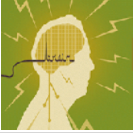Reading minds may no longer be science fiction. Brain waves can be sent through the Internet to create an instant message in another person’s mind.
Words to know
Brain wave: electrical activity in the brain that is recorded and displayed visually. Electroencephalography (EEG)… more
Neuron: a special cell which is part of the nervous system. Neurons work together with other cells to pass chemical and electrical signals throughout the body… more
Non-invasive: not tending to penetrate or destroy healthy tissue.
Phosphene: a flash of light in the field of view induced by electrical stimulation.
Transcranial Magnetic Stimulation (TMS): a technique which uses electromagnetic waves to activate or inactivate neurons via electric currents.
What’s in the Story?
If you became small enough to walk around inside the brain you would see a breathtaking electrical pattern around you. Specialized cells of the brain, known as neurons, use electricity (and chemicals) to carry information across vast networks. Scientists believe there may be about 85-100 billion neurons in the human brain. You would see billions of flashes of light across the surface of the brain as messages traveled from one region to another.

Using magnetic fields it is possible to alter neuron and brain wave activity. Image by Eric Wassermann, M.D. National Institutes of Health
Neurons work like the circuits for the lights in your room. It’s possible for scientists to not only record the electricity of your brain but change it too. One such tool, called transcranial magnetic stimulation (TMS) uses magnets like you might play with to attract paper clips. Focusing a magnetic field lets scientists play with the volume of different brain areas. You could actually make someone hungry or move parts of their body with the flick of a switch.
You can use TMS to direct electricity to certain areas of the brain responsible for helping you see. You might see spooky flashes of light in your eyesight known as phosphenes. They can be useful for studying how different parts of the brain work.
Sending a Message with Your Brain
Changing brain activity isn’t the hard part with mind reading. The toughest part is moving the signal and getting it to the right area. To train people to use their noggin, scientists had them play a video game moving a ball up and down on a screen. The people would then bounce the ball off a wall. To move the ball, the people had to imagine moving their hands or feet. Whenever they thought of moving their hands the ball would float up to the top. If they thought about moving their feet it would fall down to the bottom. Imagine if to play a game all you had to do was think about moving.
If the person got the ball to the right spot something amazing would happen. Little pads on their scalp would record the neurons and send it to the internet. This would travel all the way from India to France. Another person would receive little bursts of magnet activity by the TMS. When people got the proper message they would see the phosphenes mentioned earlier. Little flashes of light, even when they were blindfolded.
Brain-to-Brain Instant Messaging

Memories can be transferred between rats. Imagine being able to share experiences by downloading them from your friend! Image by AlexK100
This is not the first time we’ve been sending messages from the brain of one animal to another. Scientists went right into the brain of rats and moved memories from one rat into another! (Deadwlyer et al., 2013) These furry little guys could solve puzzles they had never seen before. They borrowed the memory from another animal.
The problem with memory sharing like this is that we have to dig inside the brain of the critter involved. This can hurt other parts of the brain. Scientists have been looking for non-invasive ways of changing and measuring the brain. That is just a fancy way of saying that we want to play with the brain without cracking open anyone’s skull. These scientists using pong and TMS shows us a way that we could send messages in the future by playing video games.
The next big problem is that sometimes we want to send really long messages. Playing games like this would be hard to send anything longer than a “yes” or “no.” In the future it might be possible to write entire letters to friends and family. Just close your eyes and think about them.
Additional images from Wikimedia Commons. Brain waves image by Nevit Dilmen.
Bibliographic details:
- Article: Brain-to-Brain Instant Messaging
- Author(s): Christopher Albin-Brooks
- Publisher: Arizona State University School of Life Sciences Ask A Biologist
- Site name: ASU – Ask A Biologist
- Date published: June 30, 2017
- Date accessed: September 24, 2021
- Link: https://askabiologist.asu.edu/plosable/brain-messaging







